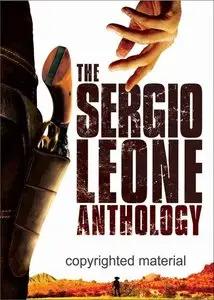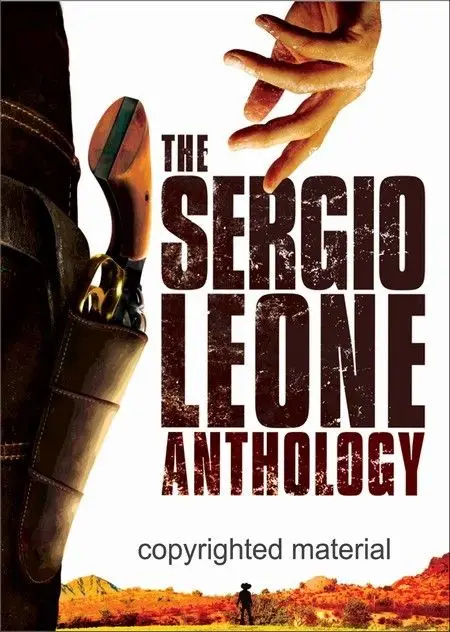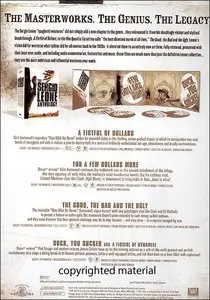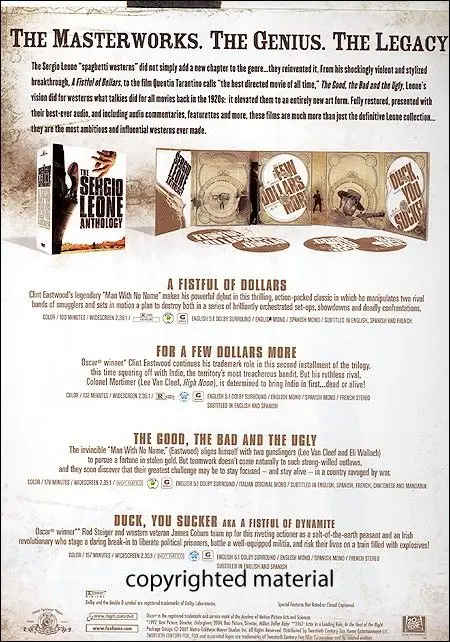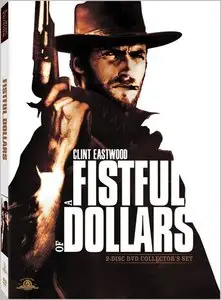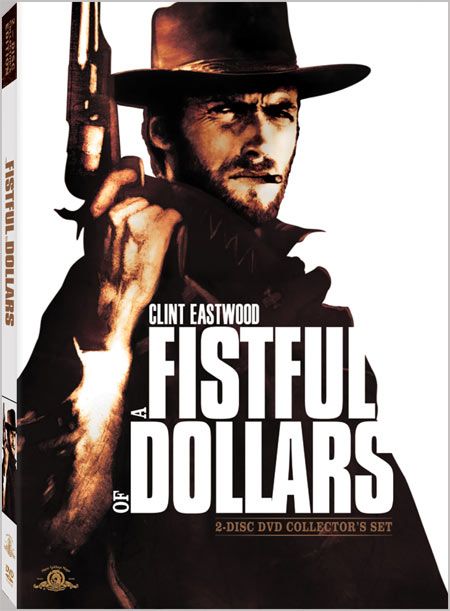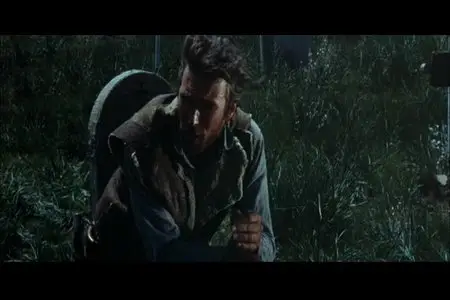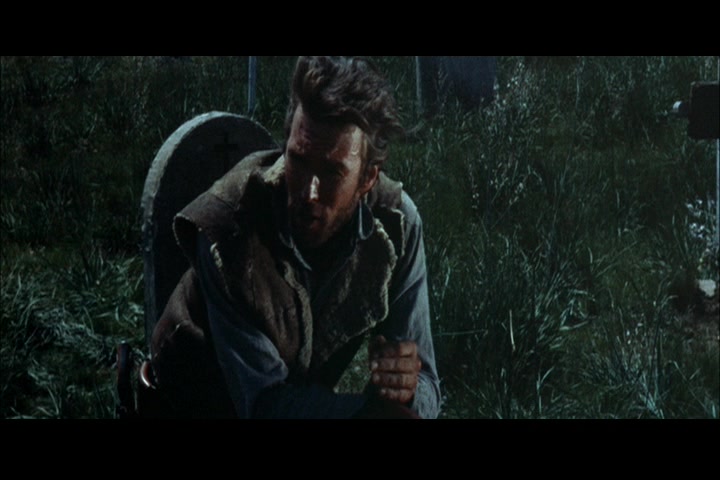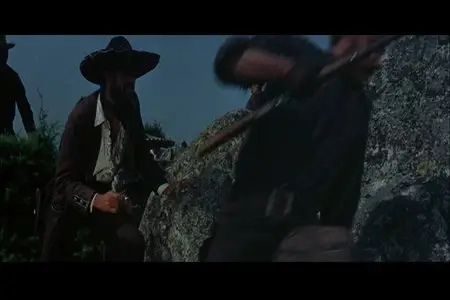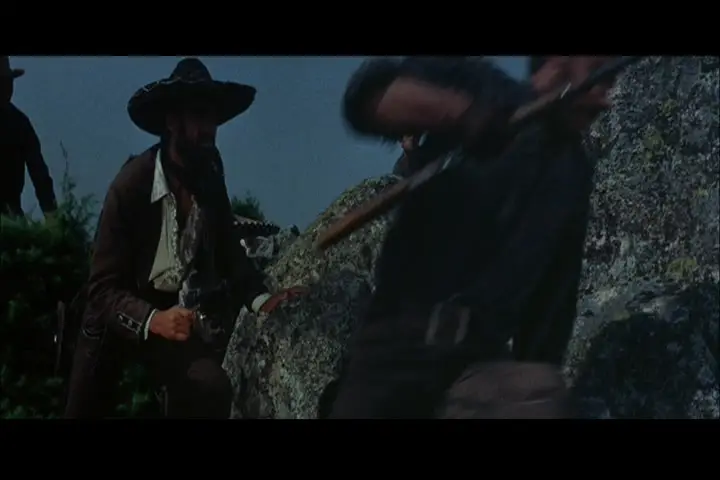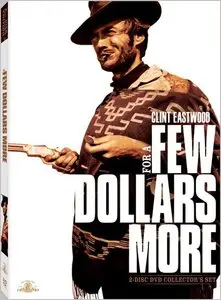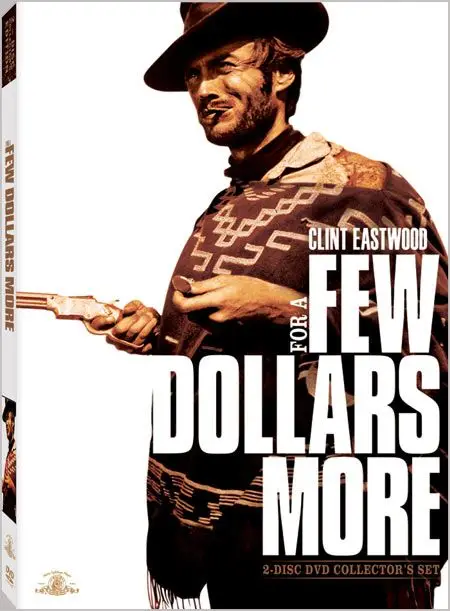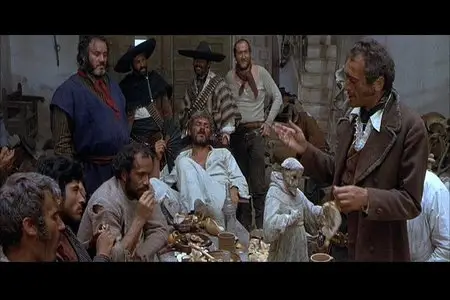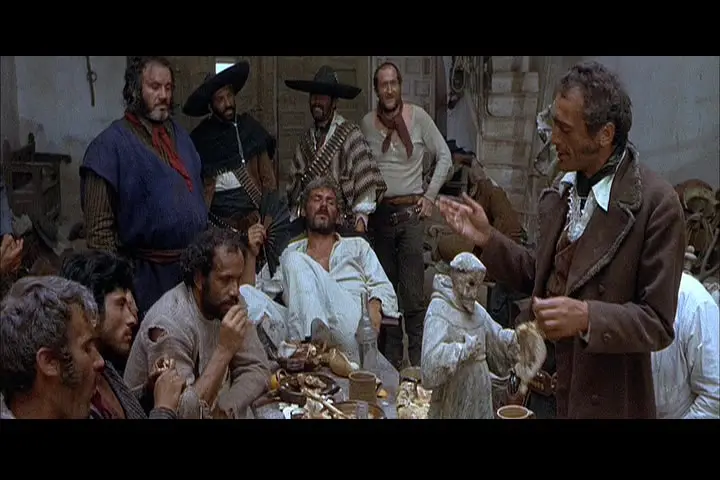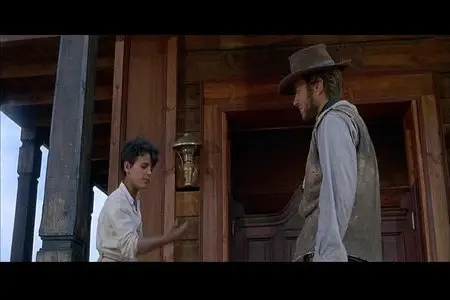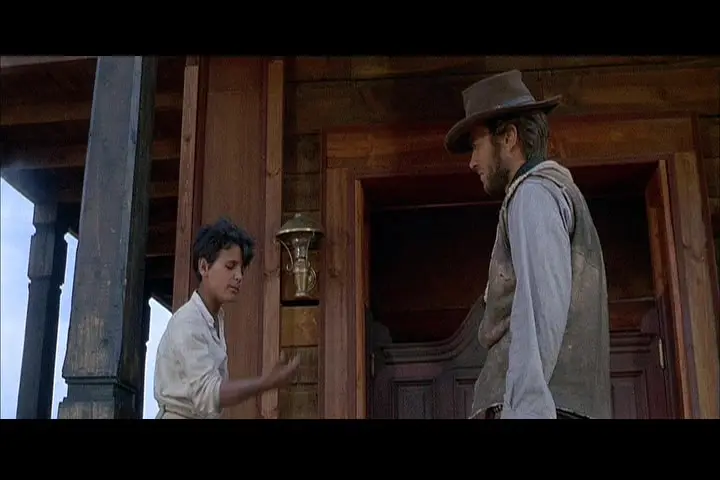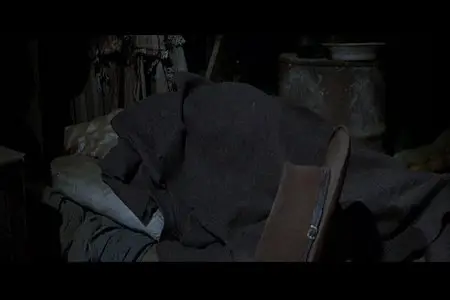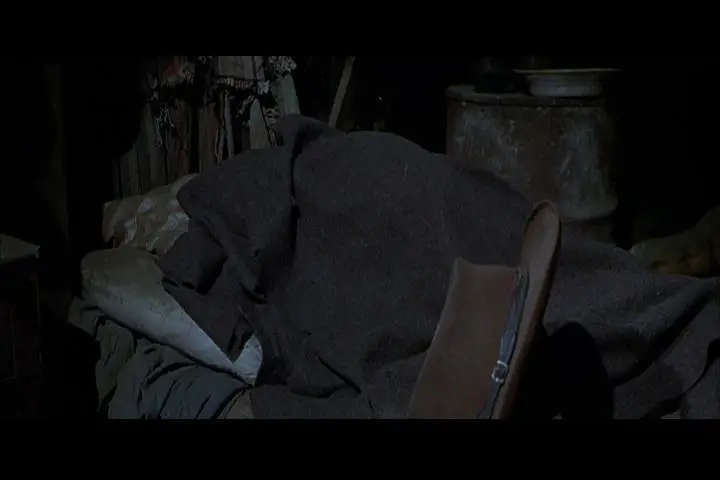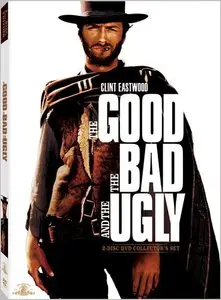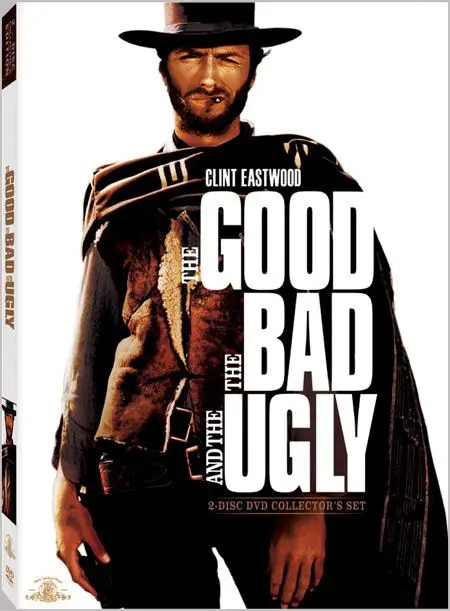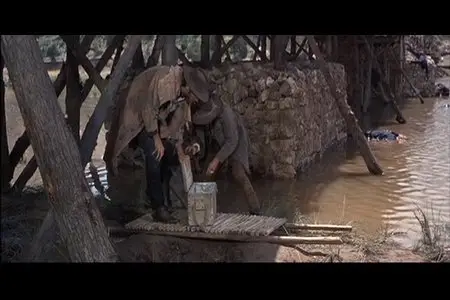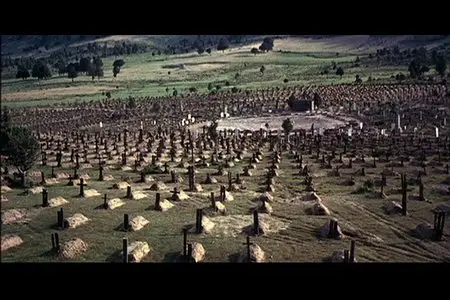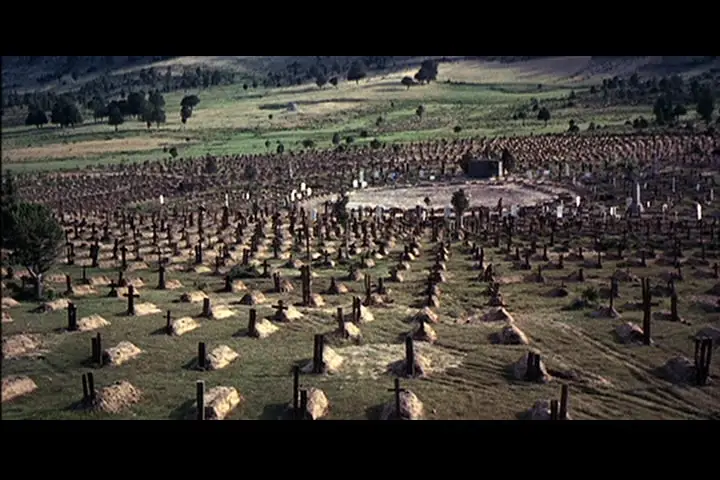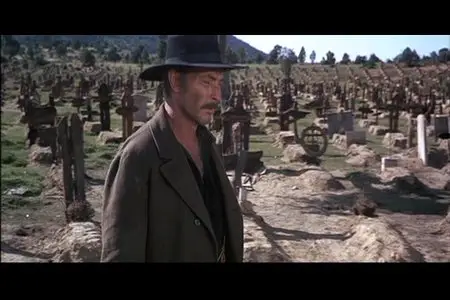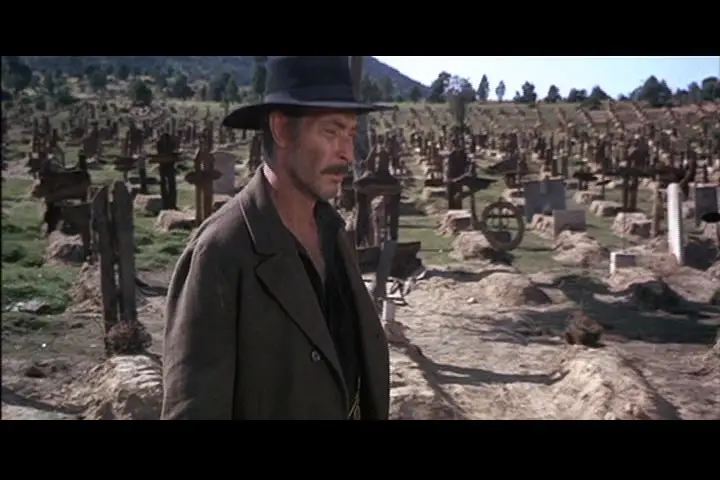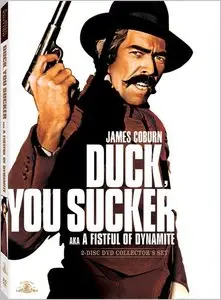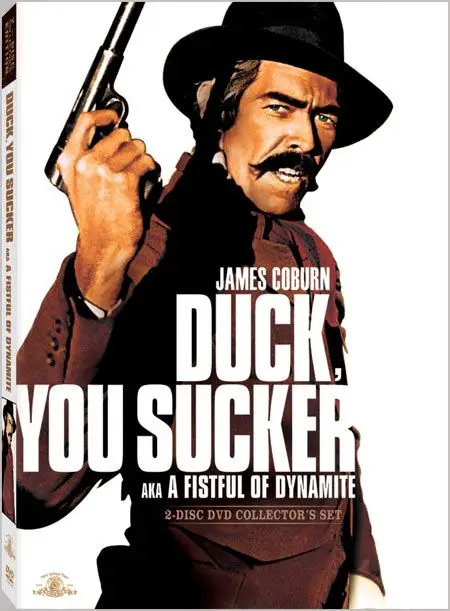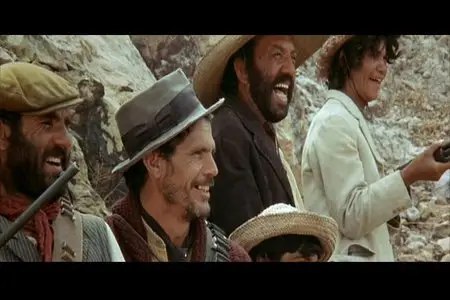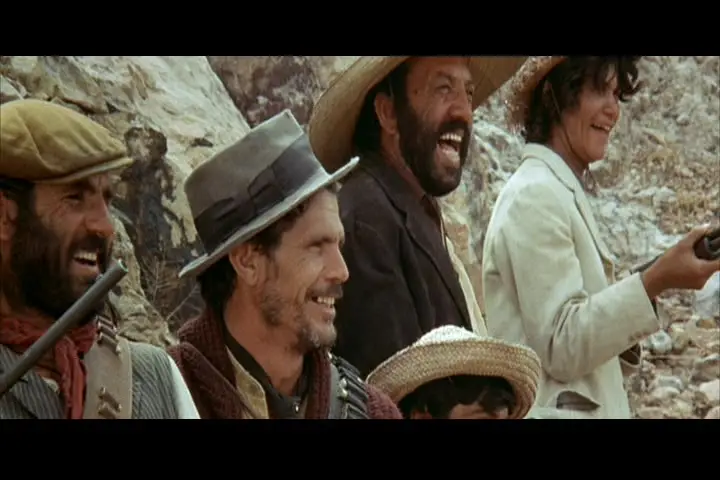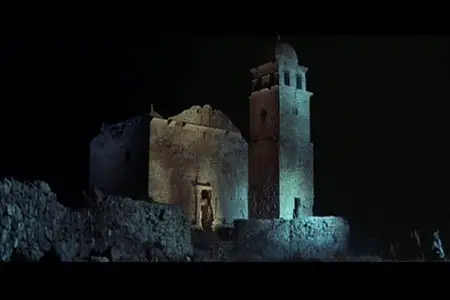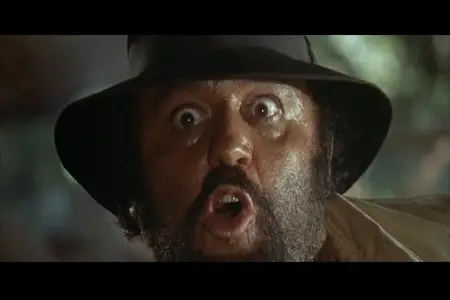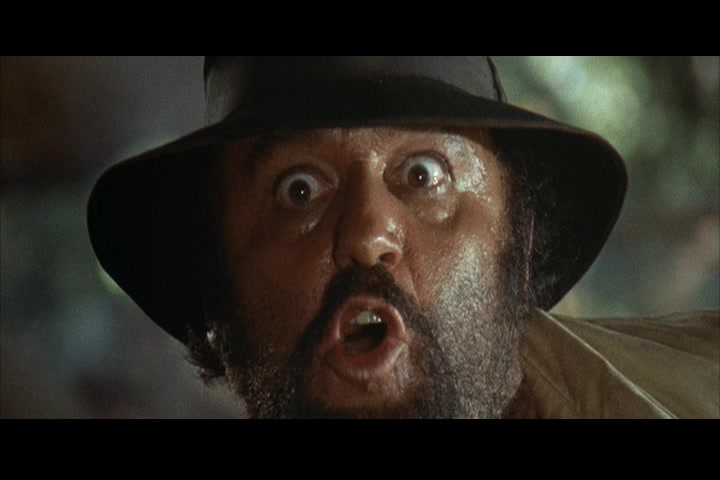The Sergio Leone Anthology (A Fistful Of Dollars / For A Few Dollars More / The Good, The Bad And The Ugly / Duck, You Sucker) (1964-1971)
4xDVD9 + 4xDVD5 | ISO | NTSC | 16:9 | 720x480 | MPEG2 | Full time: 568 minutes | Total 46.1Gb
Audio: English, AC3, 6ch, 448kpbs | Subtitles: English, French, Spanish (see below)
USA | Western
4xDVD9 + 4xDVD5 | ISO | NTSC | 16:9 | 720x480 | MPEG2 | Full time: 568 minutes | Total 46.1Gb
Audio: English, AC3, 6ch, 448kpbs | Subtitles: English, French, Spanish (see below)
USA | Western
Four classic Leone movies given the deluxe treatment and FINALLY released in the U.S. on DVD
Director : Sergio Leone
Original Music : Ennio Morricone
From the innovative "James Bond Western" style of A Fistful of Dollars (1964) to the complete restoration of Duck You Sucker (1971), The Sergio Leone Anthology pays lavish tribute to one of the greatest of all Italian directors. A lifelong film buff deeply influenced by the movies he enjoyed as an uneducated youth in southern Italy, Leone (1929-1989) had officially directed only one previous film (1961's The Colossus of Rhodes) when he recruited a relatively unknown American TV star named Clint Eastwood (on a modest salary of $15,000) and made cinema history with A Fistful of Dollars, not the first Western made by an Italian but certainly the first truly Italian entry in the "Spaghetti Western" genre that Leone virtually invented. Each of the four films included in this eight-disc set are influential milestones in that once-maligned, now-celebrated genre, and while Leone's classic Westerns were largely dismissed by critics throughout the 1960s and '70s, they now stand as the masterworks of a visionary artist who was posthumously elevated into the pantheon of world-class filmmakers. To acknowledge Leone's historic impact on the genre, the Leone Anthology includes MGM's previous two-disc extended-cut collector's edition of The Good, the Bad, and the Ugly (1966), and applies the same deluxe treatment to A Fistful of Dollars, For a Few Dollars More (1965), and, for the first time on DVD, the fully restored English-language version of the original 157-minute Italian cut of Duck You Sucker (previously known by its alternate U.S. title A Fistful of Dynamite), which was never shown in American theaters.
A Fistful of Dollars is best known in America for spawning the "Man With No Name" marketing campaign that made Eastwood a star, although Eastwood's character is clearly named "Joe" in this cleverly adapted low-budget remake of Akira Kurosawa's samurai classic Yojimbo, in which Eastwood's lone drifter vies for strategic advantage in a corrupt Mexican town divided by a bitter family feud. The operatic qualities that grew increasingly lavish in Leone's later films are evident here on a smaller scale, along with the modern, innovative score of Ennio Morricone, whose legendary collaborations with Leone (on all four of these films) were vital to the director's deliberate defiance of Hollywood's Western traditions. Fistful was an instant success in Italy and its immediate sequel, For a Few Dollars More, is often cited as the definitive Spaghetti Western, with a bigger budget ($600,000) and a charismatic costar with Eastwood (Lee Van Cleef) in an uneasy alliance between gunslingers that introduced a hint of humanity to Leone's increasingly de-mythologized vision of the West. While teaming Eastwood, Van Cleef, and Eli Wallach in a ruthless Civil War-era quest for buried Confederate gold, The Good, The Bad, and The Ugly completed Leone's "Dollars" trilogy (filmed primarily on locations in Spain) on a truly epic scale, introducing the darker cynicism, grander ambition, and artistic maturity that defined Leone's later films.
Leone vowed to quit making Westerns after his 1968 masterpiece Once Upon a Time in the West (a Paramount release not included in this set), but circumstances led him to seize the directorial reins of Duck You Sucker, a dynamic yet deeply disillusioned study of revolution that can now take its rightful place among Leone's greatest films. Like several of Leone's films, Duck You Sucker suffered a long history of cuts, re-cuts, and censorship, and the fully restored 157-minute version (unseen since the film's 1971 Italian premiere) more effectively explores the complex friendship between an Irish rebel explosives expert (James Coburn) and a brutish Mexican bandit (Rod Steiger) who becomes a reluctant revolutionary in 1913 Mexico. With explosive action sequences that remain among the most impressive ever filmed, Duck You Sucker now gives richer meaning to the film's original Italian title Giù la testa ("Keep Your Head Down"), asserting Leone's theme that family is far more important than the devastating violence of revolution. In the Leone Anthology (a variation on previous DVD sets released in England, Germany, and Japan), Duck You Sucker is the long-awaited crown jewel in a box-set of cinematic treasures. And while Leone purists will endlessly debate over the image quality (generally quite impressive) and 5.1-channel soundtrack mixes included here, there's no denying that The Sergio Leone Anthology is the definitive Leone tribute for a technically demanding 21st-century audience, and that's cause for enthusiastic celebration. –Jeff Shannon
On the DVDs
Listed is the eight-disc set (also including cast lists, scene selections, brief synopses, and behind-the-scenes details), the bonus features found in The Sergio Leone Anthology provide a comprehensive study of Leone's career, themes that dominated his work, and the historical contexts that inform Leone's classic "Spaghetti Westerns." With an even balance of lively authority and erudite scholarship, acclaimed Leone biographer and British film historian Sir Christopher Frayling provides informative commentary on A Fistful of Dollars, For a Few Dollars More and Duck You Sucker, while Time magazine critic Richard Schickel's equally astute commentary remains on MGM's previous two-disc release of The Good, the Bad, and the Ugly. (Many of these features were prepared for the U.K. version of The Leone Anthology, including interviews conducted in 2003 and 2005.) In addition to a wide variety of vintage American radio promotional spots for these films, the meticulously researched and delightfully fascinating "location comparisons" show "then and now" scenes from all four films, with original film clips perfectly matched to location photos taken in 2004 by devoted Leone fans Donald S. Bruce and Marla J. Johnson.
Extras on A Fistful of Dollars begin with "A New Kind of Hero" (22:53), Frayling's behind-the-scenes analysis of the film's innovative anti-hero played by Clint Eastwood, whom Leone hired (when first choices Henry Fonda, James Coburn, Lee Marvin, and Charles Bronson proved too expensive) after seeing Eastwood in a 1961 episode of Rawhide. In the interview featurette "A Few Weeks in Spain" (8:33), Eastwood recalls the experience of making the film on location, and "Tre Voci" (or "Three Voices") is an 11-minute combination of retrospective interviews with producer Alberto Grimaldi, screenwriter Sergio Donati, and Mickey Knox, an American actor living in Rome who provided many of the post-synchronized voices for the English-language versions of Leone's films. In "Not Ready for Prime Time" (6:20), maverick American director Monte Hellman describes the circumstances that led to his direction of an explanatory Fistful of Dollars prologue for the film's American network TV premiere on August 29, 1977. Featuring Harry Dean Stanton, and filmed as an attempt to "legitimize" the Man With No Name's seemingly immoral behavior, the rarely-seen prologue (7:44) is introduced by obsessive Leone fan Howard Fridkin, who saved his Betamax recording from the one-time-only 1977 broadcast.
Frayling examines For a Few Dollars More in "A New Standard" (20:15), a "making of" featurette with emphasis on the film's male/male dynamic (described by Frayling as Leone's "invention of the brother he never had"). In "Back for More" (7:08), Eastwood recalls how he'd begun to watch Leone to inform his own directorial ambitions. "Tre Voci" (11:05) continues the retrospective interviews with Grimaldi, Donati, and Knox, and "The Original American Release Version" (5:19) examines three edits (including removal of the name "Manco" so Eastwood's character could remain "nameless" in the film's American marketing) that were made for the film's U.S. release.
Extras on The Good, the Bad, and the Ugly are highlighted by "Leone's West" (19:53) and "The Leone Style" (23:47), a pair of excellent documentaries exploring the film itself and the evolution of Leone's visual style as his budgets and production values grew to epic proportions. Featuring interviews with Clint Eastwood, critic and Eastwood biographer Richard Schickel, and others, these are must-see features packed with entertaining observations and anecdotes. Lending historical context to Leone's film, "The Man Who Lost the Civil War" is a 14-minute excerpt from a documentary about ill-fated Confederate general Henry Hopkins Sibley's botched campaign to expand Confederate dominance in the West. The "Reconstruction" featurette (11:07) is a detailed study of The Good, the Bad, and the Ugly's painstaking restoration to Leone's intended 179-minute extended cut, featuring an interview John Kirk, the MGM director of technical operations who supervised the film's meticulous reconstruction. The essential contribution of composer Ennio Morricone is celebrated in the "Il Maestro" featurette (7:47) and film music historian Jon Burlingame provides an excellent audio-only survey (12:29) of Morricone's most popular soundtrack. Deleted scenes include the extended "Tuco torture" sequence (in which the brutal beating of Eli Wallach's character is masterfully cross-cut with the melancholy performance of a prison-camp orchestra); the brilliant "Socorro sequence" that was drastically edited in previous cuts; and a French trailer revealing shots and alternate angles not seen in the film's various theatrical releases. The poster gallery includes eight posters from the film's international marketing campaigns.
For Duck You Sucker, Frayling's film-by-film analysis continues in "The Myth of Revolution" (22:10), a behind-the-scenes study of Leone's deepening artistic maturity, as manifested in the film's cynical view of political revolution. "Donati Remembers" (7:20) is a continuation of the retrospective interview with screenwriter Sergio Donati (who by the early '70s was urging Leone to return to smaller-scale filmmaking), and "Once Upon a Time in Italy" (6:00) explores the ambitious effort that went into creating the definitive traveling exhibit of material (props, posters, costumes, etc.) from Leone's archives and beyond, first shown at the Gene Autry Museum of Western Heritage, in Los Angeles, California, in July 2005. In "Sorting Out the Versions" (11:37), film historian Glenn Erickson narrates a visual survey of the various cuts and changes made to Duck You Sucker during its tortured history of global distribution, and in "Restoration Italian Style" (6:07), MGM director of technical operations John Kirk outlines the painstaking effort to restore Duck You Sucker to its original Italian premiere length of 157 minutes, resulting in the first-ever English language version based on the film's Italian-language restoration of 1996. The disc concludes with the enjoyable "Location Comparisons" (9:32), six rare radio spots from the film's original U.S. release in 1972, and (as with all other films in this set) the original theatrical trailer. –Jeff Shannon
Product Description
Disc 1: THE GOOD, THE BAD AND THE UGLY Collector's Edition Disc 2: THE GOOD, THE BAD AND THE UGLY Bonus Disc Disc 3: A FISTFUL OF DOLLARS Collector's Edition Disc 4: A FISTFUL OF DOLLARS Bonus Disc Disc 5: FOR A FEW DOLLARS MORE Collector's Edition Disc 6: FOR A FEW DOLLARS MORE Bonus Disc Disc 7: DUCK, YOU SUCKER (A FISTFUL OF DYNAMITE) Collector's Edition Disc 8: DUCK, YOU SUCKER (A FISTFUL OF DYNAMITE) Bonus Disc
~ Amazon.com
–––––––––––––––––––––––––
A Fistful Of Dollars (1964)
DVD9 + DVD5 | ISO | ISO | NTSC | 16:9 | 720x480 | MPEG2 | 8200kbps | 11.4Gb
Audio: #1 English, AC3, 6ch, 448kpbs | #2 Spanish, AC3, 2ch, 192kbps
Subtitles: English, French, Spanish
DVD9 + DVD5 | ISO | ISO | NTSC | 16:9 | 720x480 | MPEG2 | 8200kbps | 11.4Gb
Audio: #1 English, AC3, 6ch, 448kpbs | #2 Spanish, AC3, 2ch, 192kbps
Subtitles: English, French, Spanish
IMDb
Starring : Clint Eastwood, Marianne Koch, Gian Maria Volontè, Wolfgang Lukschy, Seighardt Rupp, Joe Egger, Aldo Sambrell, Mario Brega
Special features:
- Feature Commentary By Noted Film Historian Sir Christopher Frayling
- A New Kind Of Hero Featurette
- A Few Weeks In Spain:Clint Eastwood On The Experience Of Making The Film
- Tre Voci: Three Friends Remember Sergio Leone
- Not Ready For Primetime: Renowned Filmmaker Monte Hellman Discusses The Television Broadcast of A Fistful Of Dollars The Network Prologue With Harry Dean Stanton
- Location Comparisons Then To Now: Film Clips With Current Footage Of The Locations Used
- 10 Radio Spots
- Double-Bill Trailer
Fistful of Dollars (the on-screen title has no "A", despite MGM's ad copy) is an inexpensive movie. If this transfer looks less attractive than the others its partly because it wasn't as carefully photographed, and because of a lack of access to prime transfer elements. The transfer doesn't look bad overall, although one can still perceive a 'pulsing' quality in some scenes, especially shots in Joe's first gundown, the "my mule is upset" scene. Otherwise the enhanced transfer cleans up a great many flaws.
The first three films were originally monaural, although MGM has remixed them all in processed faux-stereo. One of the main complaints about the extended version of GBU is that the original mix had been augmented (many fans said defaced) with extra sound effects, and both dialogue and music were altered. Early suspicions about this new release centered on whether MGM would respect the integrity of the original films by retaining the original mono tracks. Happily, mono tracks are provided for the three new restorations. Fistful of Dollars has a Spanish mono as well.
Informed fans mention scenes present in some foreign versions but never seen in UA's export copy, including a scene of the Baxters sitting at the Rojo's dinner table. All of these films were customized for release in different countries. Some scenes were cut after initial engagements, or were perhaps set aside yet reinstated when local censors cut other scenes. When it's difficult to simply get a useable transfer element from a foreign producer, looking for variant versions is not always possible.
The extras feature actor Clint Eastwood and English Leone authority Sir Christopher Frayling. Frayling's entertaining commentaries and interview featurette (A New Kind of Hero) constitute a compressed history of everything related to the Leone cycle – American and Italian film history, the story of the Italian film industry and detailed insights into practically every face we see on the screen. In the featurette A Few Weeks in Spain Eastwood tells the story of a serious actor who made good, due in no small part to his professional pride in his work. While other American actors abroad just read the lines, rode the horses and headed back to the nightclubs, Eastwood rewrote his own dialogue, kept his own script notes and then made sure it was recorded correctly in dubbing sessions. "The Man with No Name" thus comes off as the coolest gunslinger in history.
The featurette Tre Voci gathers the memories of producer Alberto Grimaldi, writer Sergio Donati and actor/dubbing director Mickey Knox. Also of interest is Donald Bruce's Location Comparisons that match film scenes with new photography of the same locations today. Some sets are completely gone but others remain intact.
Curious Leone fans will most want to see the Network Prologue that was added to Fistful of Dollars for its first prime-time TV showing in 1977. Thought long lost, the prologue was preserved by fan Howard Fridkin, who recorded it on one of the very first Betamax VCRs. On a separate extra, Not Ready for Prime Time, director Monte Hellman remembers directing the amusingly inept prologue, with actor Harry Dean Stanton and an unconvincing stand-in for Clint Eastwood.
–––––––––––––––––––––––––
For A Few Dollars More (1965)
DVD9 + DVD5 | ISO | ISO | NTSC | 16:9 | 720x480 | MPEG2 | 7000kbps | 12.1Gb
Audio: #1 English, AC3, 6ch, 448kpbs | #2 French, AC3m 2ch, 192kbps | #3 Spanish, AC3, 2ch, 192kbps
Subtitles: English, Spanish
DVD9 + DVD5 | ISO | ISO | NTSC | 16:9 | 720x480 | MPEG2 | 7000kbps | 12.1Gb
Audio: #1 English, AC3, 6ch, 448kpbs | #2 French, AC3m 2ch, 192kbps | #3 Spanish, AC3, 2ch, 192kbps
Subtitles: English, Spanish
IMDb
Starring : Clint Eastwood, Lee Van Cleef, Gian Maria Volontè, Maria Krup, Luigi Pistilli, Klaus Kinski, Joseph Egger, Aldo Sanbrell
Special features:
- Commentary by Noted Film Historian Sir Christopher Frayling
- A New Standard: Sir Christopher Frayling On For A Few Dollars More
- Back For More: Clint Eastwood Remembers For A Few Dollars More
- Tre Voci: Three Friends Remember Sergio Leone
- For A Few Dollars More: The Original American Release Version Comparison Featurette
- Location Comparisons Then To Now: Film Clips Intercut With Current Footage Of The Locations Used
- 12 Radio Spots
- Original Theatrical Trailer
More lavishly produced than the first film, For a Few Dollars More is perhaps the best-looking of the four titles on DVD, with brilliant colors and a clean image that belies its half-frame Techniscope origins. The quality can be traced to a complete overhaul of the movie by the restoration company Triage. Paul Rutan went back to the original Techniscope negative, enlarging and squeezing the image through optics much better than those used in 1965. In addition to a new Dolby 5.1 remix, this disc has original mono tracks in English, Spanish and French. MGM's 1999 release was flat letterboxed, with much of its audio track painfully out of sync, making the new disc a vast improvement.
Christopher Frayling and Clint Eastwood repeat their contributions in a reminiscence-filled featurette from the actor (Back for More) and a commentary and full featurette (A New Standard) from the educator/author. The Tre Voci trio also contribute more stories, especially about the hiring of star Lee Van Cleef. A second set of Location Comparisons is on board as well.
MGM's versions of For a Few Dollars More have taken criticism for not being 'complete,' because foreign tapes and TV presentations have extensions on a couple of scenes. MGM has a battered copy of a longer cut in which Manco and Mortimer are beaten by El Indio's thugs, but decided not to include it as it would not match the rest of the film in quality. Whether by accident or intention, the extended beating scene is no longer part of producer Alberto Grimaldi's original negative. On this new disc it can be seen in a Comparison featurette that shows a couple of other differences in the MGM copy, but is by no means comprehensive. This new feature restoration does retain the brief scene extension identifying Eastwood's character with the name 'Manco.' It was presumably snipped by UA in 1967 to maintain the 'Man with No Name' ad concept.
Christopher Frayling and Clint Eastwood repeat their contributions in a reminiscence-filled featurette from the actor (Back for More) and a commentary and full featurette (A New Standard) from the educator/author. The Tre Voci trio also contribute more stories, especially about the hiring of star Lee Van Cleef. A second set of Location Comparisons is on board as well.
MGM's versions of For a Few Dollars More have taken criticism for not being 'complete,' because foreign tapes and TV presentations have extensions on a couple of scenes. MGM has a battered copy of a longer cut in which Manco and Mortimer are beaten by El Indio's thugs, but decided not to include it as it would not match the rest of the film in quality. Whether by accident or intention, the extended beating scene is no longer part of producer Alberto Grimaldi's original negative. On this new disc it can be seen in a Comparison featurette that shows a couple of other differences in the MGM copy, but is by no means comprehensive. This new feature restoration does retain the brief scene extension identifying Eastwood's character with the name 'Manco.' It was presumably snipped by UA in 1967 to maintain the 'Man with No Name' ad concept.
–––––––––––––––––––––––––
The Good, The Bad And The Ugly (1966)
DVD9 + DVD5 | ISO | ISO | NTSC | 16:9 | 720x480 | MPEG2 | 4950kbps | 13.0Gb
Audio: #1 English, AC3, 6ch, 448kpbs | #2 Italian, AC3m 2ch, 192kbps
Subtitles: English, French, Spanish
DVD9 + DVD5 | ISO | ISO | NTSC | 16:9 | 720x480 | MPEG2 | 4950kbps | 13.0Gb
Audio: #1 English, AC3, 6ch, 448kpbs | #2 Italian, AC3m 2ch, 192kbps
Subtitles: English, French, Spanish
IMDb
Starring : Clint Eastwood, Eli Wallach, Lee Van Cleef, Aldo Giuffre, Mario Brega, Luigi Pistilli
Special features:
- Audio Commentary by Film Historian Richard Schickel
- Deleted Scenes
- Leone's West Making-Of Documentary
- The Leone Style Documentary on Sergio Leone
- The Man Who Lost The Civil War Civil War Documentary
- Reconstructing The Good, The Bad And The Ugly Featurette On Composer Ennio Morricone
- Poster Gallery
- Original Theatrical Trailer
As stated above, The Good, The Bad and The Ugly is the same two-disc extended edition that can be read about in Savant's original review. For a splashy 2003 theatrical re-release the film was restored to most of its 1966 first-run length, re-inserting a number of Italian language scenes included only as an extra on the first 1999 disc. MGM and Alberto Grimaldi also restored a 'grotto' scene that never saw general release, but was finished and shown at the film's 1966 Rome premiere. The grotto scene became controversial mostly through the disapproval of the Leone family, as interpreted by various highly placed fans. MGM reinstated the scenes with the approval of the film's producer.
Less clear-cut is MGM's audio remix of GBU, which for the new theatrical release was expanded to fill the Dolby soundscape. Clint Eastwood and Eli Wallach returned to the recording studio to voice the new segments that had never before been dubbed into English. The loudest web objections are pointed at MGM's augmentation and replacement of key sound effects – gunshots, cannon blasts – to 'fill out' the new stereo track. Dissenting fans still have a reason to complain, as this new release still lacks an original (or mostly original) mono option in English. (It does have an Italian original mono track).
Sir Christopher Frayling was unavailable back when the extras for The Good, The Bad and The Ugly were created, and Richard Schickel provided a commentary instead. In 2004 Frayling recorded a full commentary for GBU with the idea that it could be added as an extra on a reissue. MGM has instead reissued the GBU discs unchanged.
Less clear-cut is MGM's audio remix of GBU, which for the new theatrical release was expanded to fill the Dolby soundscape. Clint Eastwood and Eli Wallach returned to the recording studio to voice the new segments that had never before been dubbed into English. The loudest web objections are pointed at MGM's augmentation and replacement of key sound effects – gunshots, cannon blasts – to 'fill out' the new stereo track. Dissenting fans still have a reason to complain, as this new release still lacks an original (or mostly original) mono option in English. (It does have an Italian original mono track).
Sir Christopher Frayling was unavailable back when the extras for The Good, The Bad and The Ugly were created, and Richard Schickel provided a commentary instead. In 2004 Frayling recorded a full commentary for GBU with the idea that it could be added as an extra on a reissue. MGM has instead reissued the GBU discs unchanged.
–––––––––––––––––––––––––
Duck, You Sucker (1971)
DVD9 + DVD5 | ISO | ISO | NTSC | 16:9 | 720x480 | MPEG2 | 5100kbps | 12.7Gb
Audio: #1 English, AC3, 6ch, 448kpbs | #2 French, AC3m 2ch, 192kbps | #3 Spanish, AC3, 2ch, 192kbps
Subtitles: English, Spanish
DVD9 + DVD5 | ISO | ISO | NTSC | 16:9 | 720x480 | MPEG2 | 5100kbps | 12.7Gb
Audio: #1 English, AC3, 6ch, 448kpbs | #2 French, AC3m 2ch, 192kbps | #3 Spanish, AC3, 2ch, 192kbps
Subtitles: English, Spanish
IMDb
Starring : James Coburn, Rod Steiger, Maria Monti, Rik Battaglia, Romolo Valli, Antoine St-John, Vivienne Chandler, David Warbeck
Special features:
- Audio Commentary by Noted Film Historian Sir Christopher Frayling.
- Sergio Donate Remembers Duck, You Sucker Featurette
- The Myth Of Revolution: Sir Christopher Frayling Discusses Leone's Political Leanings, His Method And His Style
- Once Upon A Time In Italy (AKA: The Autry Exhibition): A Behind-The-Scenes Look At Putting Together An Exhibit On Leone
- Sorting Out The Versions Featurette
- Restoration Italian Style: John Kirk Discusses Restoring The Original Italian Version For The First DVD Release
- Location Comparisons Then To Now: Film Clips Intercut with Current Footage Of The Locations Used
- 6 Radio Spots
- Original Theatrical Trailer
Duck You Sucker has been the least appreciated of Leone's films until fairly recently; this is its first appearance on DVD. Equally as slow as Once Upon a Time in The West, it represents a leap forward for the director. Leone not only tackles believable human relationships for the first time, he also has serious political ideas to communicate. It's interesting that he did not intend to direct the film or think it was a 'personal' effort, when his next signed picture thirteen years later Once Upon a Time in America continues in the same socio-political vein.
In America Duck You Sucker was chopped into bits for several reasons. Leone's previous Paramount release had been a box office failure and United Artists had no interest in another three-hour artistic western. They removed as much 'revolutionary' content as possible, trimmed some profanities here and there and then re-cut the show to speed up the slow scenes. The 160-minute picture was officially 138 for American release, but I know that in Los Angeles some prints were slashed to 120 minutes for second-runs.
The picture billboards Leone's graces and his faults. The enormous production is truly grandiose in the battle scenes, including an amazing night-for-night final battle. Thousands of costumed extras jam railroad stations. Throwaway glimpses through the windows of a railroad car reveal moving trains, mounted soldiers and hundreds of extras milling about. An awesome bridge detonation filmed in ultra slow motion sends boulder-sized rocks flying, as if a meteor had collided with the earth.
On the downside, Leone still undervalues the need for a coherent narrative. He ellipses huge sections of story while retaining extended 'atmosphere' scenes to showcase Ennio Morricone's sublime music score. As in Once Upon a Time in The West, the tale's central turning point is short-changed, giving us a Grindhouse impression of a reel gone missing. Both films play like four-hour two-parters that have been compromised. It's too bad that Leone couldn't create in the "episodic epic" form afforded Fritz Lang at Ufa, or Peter Jackson at New Line.
MGM's restored Duck You Sucker is based on Claver Salizzato's 1995 restoration of the Italian premiere version, which originally had a stereophonic track. The handsome transfer includes all known 'missing sections' of the film. A later French release excised the film's controversial final flashback entirely. It's the one scene that distinguishes this version from the 1997 MGM/Image Laserdisc that caused a great deal of excitement by upping the film's running time from 138 to 154 minutes. Salizzato's original stereo tracks could not be used because they had been mixed for the Italian language only. The 5.1 stereo heard here is another electronic reprocessing job; alternate tracks are provided in English, Spanish and French Mono. I've heard some alarms on the web that music cues in the film have been altered, but John Kirk says that he had no issues with the music and changed nothing. The web reports say that the music in the crucial 'entering the pub' flashback is different. I had no VHS source to check, but I did pull out both the 1990 and 1997 Image Laserdiscs to compare them with the new version. The music for that scene is the same on all of them. The confusion may be that the original soundtracks begin the music cue a bar or two earlier, with the series of heavier low notes.
This release also restores the film's proper title. The reissue compromise A Fistful of Dynamite has confused viewers for 35 years.
In America Duck You Sucker was chopped into bits for several reasons. Leone's previous Paramount release had been a box office failure and United Artists had no interest in another three-hour artistic western. They removed as much 'revolutionary' content as possible, trimmed some profanities here and there and then re-cut the show to speed up the slow scenes. The 160-minute picture was officially 138 for American release, but I know that in Los Angeles some prints were slashed to 120 minutes for second-runs.
The picture billboards Leone's graces and his faults. The enormous production is truly grandiose in the battle scenes, including an amazing night-for-night final battle. Thousands of costumed extras jam railroad stations. Throwaway glimpses through the windows of a railroad car reveal moving trains, mounted soldiers and hundreds of extras milling about. An awesome bridge detonation filmed in ultra slow motion sends boulder-sized rocks flying, as if a meteor had collided with the earth.
On the downside, Leone still undervalues the need for a coherent narrative. He ellipses huge sections of story while retaining extended 'atmosphere' scenes to showcase Ennio Morricone's sublime music score. As in Once Upon a Time in The West, the tale's central turning point is short-changed, giving us a Grindhouse impression of a reel gone missing. Both films play like four-hour two-parters that have been compromised. It's too bad that Leone couldn't create in the "episodic epic" form afforded Fritz Lang at Ufa, or Peter Jackson at New Line.
MGM's restored Duck You Sucker is based on Claver Salizzato's 1995 restoration of the Italian premiere version, which originally had a stereophonic track. The handsome transfer includes all known 'missing sections' of the film. A later French release excised the film's controversial final flashback entirely. It's the one scene that distinguishes this version from the 1997 MGM/Image Laserdisc that caused a great deal of excitement by upping the film's running time from 138 to 154 minutes. Salizzato's original stereo tracks could not be used because they had been mixed for the Italian language only. The 5.1 stereo heard here is another electronic reprocessing job; alternate tracks are provided in English, Spanish and French Mono. I've heard some alarms on the web that music cues in the film have been altered, but John Kirk says that he had no issues with the music and changed nothing. The web reports say that the music in the crucial 'entering the pub' flashback is different. I had no VHS source to check, but I did pull out both the 1990 and 1997 Image Laserdiscs to compare them with the new version. The music for that scene is the same on all of them. The confusion may be that the original soundtracks begin the music cue a bar or two earlier, with the series of heavier low notes.
This release also restores the film's proper title. The reissue compromise A Fistful of Dynamite has confused viewers for 35 years.
–––––––––––––––––––––––––
The word on MGM's higly anticipated "The Sergio Leone Anthology" is good; almost nothing bad or ugly to report. The eight-DVD set turns out to be a clone of the design, format and extras from 2004's excellent upgrade of "The Good, the Bad, and the Ugly." That DVD was so good, in fact, MGM didn't change a thing in transporting it into this box set, down to the liner notes design.
All films are restored to their full running times (or as close as possible) and appear in glorious 2:35.1 anamorphic widescreen. They all come in English Dolby 5.1, but see comments below.
"A Fistful of Dollars," the first in Italian director Leone's "Man with no name" trilogy, looks smashing – far better than you'd expect for a low-budget pic from 1964. Images and audio are dead-on. If you haven't seen the film for a while, you're in for some serious fun. The film holds up beautifully and young Clint Eastwood's performance is a hoot. Quentin Tarantino calls it "the best-directed movie of all time."
The marginally less-successful sequel "For a Few Dollars More," with Lee Van Cleef, exhibits a fair amount of speckling on the otherwise decent color images. The dubbed English stereo audio option proved a bad choice – voices wandered around the front soundstage for no apparent reason. Leone purists will be listening to the straight-shot mono on these titles, anyway. You might as well join them. […].
In "The Good, the Bad and the Ugly," Eastwood biographer Richard Schickel does the heavy lifting in a commentary that, amazingly, runs on fumes only near the end of three hours. He maintains that Leone's artistry was lost on critics of the 1960s because of the debate over the film's violence (the New York Times pan was titled "The Burn, the Gouge and the Mangle"). Leone was relatively tame by today's standards, employing "an enormous amount of foreplay" before the killings, as in this movie's famous final shootout, Schickel remarks.
MGM's John Kirk covers the audio restoration, a sore spot for Leone purists. Eastwood and Eli Wallach rerecorded their voices in 2002 for the restored scenes, which had never been dubbed. (Everyone on the production just spoke whatever language they spoke.) Another actor stood in for the late Lee Van Cleef
The Anthology also includes the DVD debut of "Duck, You Sucker," a holy grail title for fans. This is the Italian cut of the 1972 Mexican adventure starring Rod Steiger and James Coburn, running at its full length of almost 3 hours.
~ Flipper Campbell
Among the truly great movie directors, few have a smaller body of work than Sergio Leone. He really only directed seven movies, and the first of those, The Colossus of Rhodes, is a standard sword-and-sandals flick with little of the true Leone touch. After that, he would make his mark with five westerns and finish with one of the great gangster films, Once Upon a Time in America. It is, however, the westerns that Leone really excelled, making some of the best in the genre. These so-called "Spaghetti Westerns" (because they were Italian-made) actually exceed in quality most of the ones made in the U.S. The Sergio Leone Anthology contains four of these five westerns.
All three of the "Man With No Name" trilogy are included. This is a bit of a misnomer; although all three movies star Clint Eastwood (in roles that would make him a major movie star), he does not play the same character. In the first film, A Fistful of Dollars, Eastwood plays a mercenary gunfighter who plays both sides in a gang war in a small Mexican town. A re-make of Yojimbo, this movie was made on a small budget, but already, in the first film in which Leone could truly express himself, he has created a minor masterpiece. As with all the movies in this set, this film comes with tons of extras including commentaries and behind-the-scenes material; especially amusing is an incompetent attempt by a TV studio to add a prologue to give the movie a bit of moral standing.
The follow-up, For A Few Dollars More, ups the ante by including Lee Van Cleef as a rival bounty hunter whose motives may be more complicated than the mere pursuit of money. And both Eastwood and Van Cleef would be back for the third "Trilogy" movie, The Good, the Bad and the Ugly. In my opinion, this may be the best western ever, and I doubt I'm alone (it rates consistently in IMDB's top ten movies). Eastwood is The Good, Van Cleef is The Bad and Eli Wallach is The Ugly, but good and evil are not really relevant terms here. It has been said that while in American Westerns, the hero is always the best with his gun, in Leone's Westerns, being the best with your gun makes you the hero, not any moral standing. The plot deals with the hunt for stolen Confederate gold during the Civil War; and while the previous films also conclude with grand showdowns, this movie has perhaps the best showdown in movie history (probably part of the reason it is one of the best films ever).
What's missing from the set is Once Upon a Time in the West, which rivals The Good, the Bad and The Ugly in quality. While this missing film deals with the end of the era of the gunfighter and the coming of civilization, the last film in the set, Duck, You Sucker, takes place after that era. Of all Leone's films, this is probably the least watched, and while good, it is bound to be a disappointment to those expecting another western like the earlier ones. Instead, this one has Rod Steiger as a bandit thief (very similar to Wallach's Tuco in The Good, the Bad and the Ugly) who is converted against his will into a revolutionary by explosives expert and ex-IRA member James Coburn. Despite moments of humor, this is the darkest movie in the set, but also forms something of a thematic transition to the gangster era of Leone's final movie, Once Upon A Time in America.
Although this set suffers from the omission of Once Upon a Time in the West, it is still a great set well worth five stars. All the movies look great with once-deleted scenes again restored and plenty of extras: each set has two discs, making this an eight disc set. Even if you've seen these movies in other formats, you should pick up this set if you enjoy westerns at all. These are not just westerns at their best, they are movie-making at its best.
~ mrliteral


